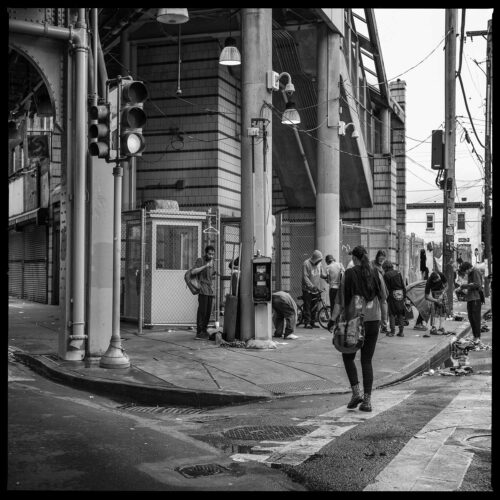
Having been banished to artistic obsolescence for the past few decades, black and white photography is enjoying a renaissance in the art world, from the new Netflix series Ripley, shot entirely in black and white, to the appearance of high-end dedicated monochrome digital cameras for consumers.
A generation ago, black and white was the gold standard for fine art photography, and most art photographers looked down their noses at color pictures. Search online and you can find pithy quotations from distinguished photographers to support this attitude, though good luck verifying any of them. “Black and white are the colors of photography,” American photo master Robert Frank supposedly said, perhaps echoing the attitude of his mentor Walker Evans, who supposedly said, “Color tends to corrupt photography and absolute color corrupts it absolutely.”
But perhaps spurred by burnout from billions of over-saturated cellphone photos and by vastly improved monochrome digital printing techniques, black and white is coming back.
You can see this for yourself in Shifting Focus, the Photography at Oregon invitational show that’s wrapping up June 7 at Maude Kerns Art Center in Eugene. The exhibition, which has taken over the entire Maude Kerns gallery space since it opened May 10, features the work of eight photographers. Five of them are showing work that’s entirely in black and white, one has printed her work in monochrome blue and white, and one has submitted hand-colored photos. That leaves a single photographer — California wildfire photographer Tracy Barbutes — working with conventional color photography.
Walk into the main gallery at the art center, and the first thing your eyes are drawn to is a series of large square black and white photos by Rochester, New York, photographer Eric Kunsman. In his series “Life-lines,” he has carefully documented a technological relic — the pay phone — in urban and rural settings around the U.S.
Kunsman is an absolute master of his craft, from composition to tonality, and each of the exquisitely detailed images rewards long and careful viewing by the visitor. The photos are so good that I hardly noticed the fact that I don’t care a whit about pay phones or their disappearance.
The most moving entry in the show is Nolan Streitberger’s elaborate re-creation of Oregon’s “Trail of Tears.” The Albany photographer uses an antique wooden view camera and 5-by-7-inch wet-plate collodion/glass negatives to shoot large, dream-like photos that track the route of the 1856 forced march of hundreds of Native Americans from their southern Oregon homes to the Grand Ronde Reservation near Lincoln City. Each of Streitberger’s photos is presented next to extracts from the handwritten journal of U.S. Indian Agent George H. Ambrose, who led the month-long, 263-mile journey, during which he reports that eight Indians died and eight were born among the hundreds forced by the Army to move.
Streitberger’s project combines imaginative photography with extensive and detailed historical and geographic research. Take the time to view each photograph and read the sometimes-haunting handwritten text from Ambrose’s journal.
Raleigh, North Carolina, photographer Rob Hammer’s documentary work records the lives of cowboys and cowgirls around the West. His subject has more popular appeal than, say, payphones, but much of his imagery, while well done, is straightforward photojournalism of a kind we’ve all seen before.
Other photographers in the show include Eugene’s Barbara Bakalarova, with hand-colored work from “Mythos,” which she’s presented recently in other local galleries; Eugene artist and photographer Sarah Grew, showing her blue-and-white cyanotypes of plankton photographed from a research boat off the Oregon coast; Willie Osterman, former curator of photography at the University of Oregon Museum of Art, with a powerful series of black and white photographs of masks from around the world; and Los Angeles photojournalist Osceola Refetoff, who has done a series of black and white landscape images using pinhole and infrared photography.
Grew, Kunsman and Streitberger will give artists’ talks in the gallery at 1 pm Saturday, June 1.
Founded in 1966 by Bernie Freemesser at the University of Oregon Art Museum, as the Jordan Schnitzer Museum of Art was then known, Photography at Oregon had the first photo gallery in a public institution on the West Coast. The organization has been without a physical home since the JSMA evicted it in 2009.
Its current exhibit at Maude Kerns offers some of the best and most substantial photography I’ve encountered in Eugene. Go see it while you can.